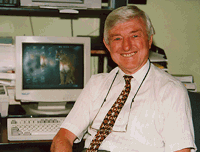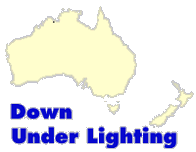

Reg. R. Wilson, MIES
1/97 © Reg. R. Wilson
E-mail comments or suggestions to regrw@acay.com.au.
Apology
This issue has been delayed for reasons totally out of the control of your correspondent. The original
intention was to post a new issue on a 6 / 8 week basis and this be the target for this year. Please accept
my apologies for this breakdown of service.
Correspondents Comment
Welcome to the third issue of Down Under Lighting. Over the last few months I have been asked for
information on the popularity of the interLight site so I queried this with Dave Burtner, President of interLight
Inc.(dkb@light-link.com) and he has advised that for September over 35,000 visits (now over 40.000) from
many parts of the world were made with over 1000 from Australia and just over 200 from NZ. Prior to the
first issue of this column about 200 visits were being made from this part of the World. The message to our
Australian / NZ. commercial visitors is that sending us your news and views not only provides general
interest here and overseas but also lets the International lighting industry know who you are and what you
are about. As always please contact me at regrw@acay.com.au.
New Environmental Software
In the first issue of Down Under Lighting we reported on the development of OLIVIA ,an outdoor lighting
design program which included the new calculations required by Interim AS 4282 -1995. Peter Jarvis of
Rayforge Services was the developer and now he announces yet another calculation program - FIONA, to
assist designers of environmentally friendly exterior lighting. FIONA is a windows based program which
allows the user to specify a zone around an oriented luminaire and calculate the luminious flux and
maximum intensity in that zone. Typical applications for this advanced program are - Compliance with
Intensity limits near airports, Dark Sky requirements, Luminaire energy efficiency analysis, Luminaire beam
dimensions and beam flux, Finding peak intensity occurrences in zones or photometric distributions. Of
particular interest for Australian / NZ viewers is that FIONA can be used for checking compliance with the
upward flux limits in the new revised SAA Street lighting standard AS 1158. The program uses an interactive
3D colour display to show the luminaire, zone and intensity distribution and has a number of viewing and
reporting options. It features the same method of operation and ease of use as the obtrusive light program
calculations program OLIVIA. Copies of both programs are available free of charge for evaluation from Peter
Jarvis at Rayforge Services at PO Box 604, Roseville, NSW 2069, Australia. Ph / Fax 61-2-9411 4927 and
e-mail: rayforge@ozemail.com.au
Lighting Scholarship
1996 is the 50th anniversary of the formation of the National Council, now the Central Council, of the
Illuminating Engineering Society of Australia and New Zealand Inc. In order to mark this milestone in our
history the Council has initiated a research scholarship.
This scholarship will be known as the Gwenyth Ewens Scholarship of 1996.
Gwenyth Ewens, who died in 1995 was a Life Fellow of the Illuminating Engineering Society of Australia and
New Zealand ( W. A, ) Inc. and was a stalwart supporter of the IES for all of her working life. Her
contributions to the Society are too numerous to list but did include financial gifts to both the Regional and
Central Societies.
The Gwenyth Ewens Scholarship is open to any financial member, of any grade, of the Society or a student ( or student team )
who is studying lighting but not yet a member of the Illuminating Engineering Society of Australia and New
Zealand Inc.
This scholarship will not be open to commercial or academic institutions although of course individuals from
such institutions can apply if they meet the stated criteria.
The scholarship, of $2,500, is to be applied for in advance, with applications giving a synopsis of the subject
and the rationale of the research.
All applications will be examined by a panel drawn from members of the Central Council and all applicants
will be notified of their success or otherwise. There can only be one successful applicant and the decision of
the panel will be final and no correspondence entered into.
This scholarship is to help with the expenses incurred by the applicant. These expenses typically may
include things such as travel, attending conferences, research and the writing and printing of the thesis. The
subject matter is to be the choice of the applicant but must have relevance to lighting in any one of it's
facets.
The thesis is to be finished by a date to be agreed between the successful applicant and the panel, and
must be available, if found suitable, to be published in the official IES magazine "LIGHTING" The
successful applicant may also be invited to present the paper at the next available, and suitable, Annual
Convention.
Final date for applications is Friday 14th. March 1997 and applications, with envelopes clearly marked
"Scholarship" should be sent to:
The President
Illuminating Engineering Society of Australia and New Zealand Inc.
PO Box 495
KOGARAH N.S.W. 2217
e-mail: iesanz@ozemail.com.au
Impressive Energy Savings
Integrated Lighting Controls based in Cheltenham, Victoria has recently reported on results obtained after
the installation of automated dimming equipment on all fluorescent lighting circuits in a large office tower in
North Sydney. This installation utilised circuit control modules featuring Constant Crest Factor (CCR)
technology combined with light sensors which ensured that lighting levels to AS 1680 requirements were
maintained.
The system provided impressive savings with an overall reduction of a total lighting energy demand of 34%
which included non controlled areas. In controlled areas the reduction was a over 45%. As a further benefit
the power factor was improved from 0.85 to 0.94. The original total lighting load for this installation was 492
kW for the 23 story building. Other benefits included an overall reduction in air conditioning loads.
Integrated Lighting Controls state that the reduction of energy for this building is almost 700Mwh per year
thus saving over 600 tonnes of carbon dioxide emission per year. A good result in any ones books.
Second Year for "Night" Zoo
After trials in 1994 Taronga Park Zoo offered the public a new concept in visiting the Zoo - see the animals
at night during the summer of 1995. Due to the great response to an extensive publicity campaign this year
saw the necessity of the prepurchasing of tickets via theatre booking agencies as it was desirable to provie
a practical limit on the number of visitors.
This interesting concept allows zoo visitors to see many animals quite active when they are normally resting
during usual daylight hours. The lighting scheme was subsidised by the local electricity supply authority
(then Sydney Electricity now Energy Australia) with conceptual design being carried out a representative
from the Sydney Opera House Trust. The basic constraint was that the presentation of the zoo should not
be an exercise in high mast flood lighting. The result is a tasteful and most interesting "moonlight effect" with
certain areas where animals might be seen provided with extra illumination. In all cases, including path
lighting, the lighting equipment is hidden in a discreet manner.
Most of the equipment utilises low voltage dichroic lamps with the luminaires being supplied by an
Australian manufacturer, Lumascape. This is "must
see" installation for any one interested in exterior lighting - - not to mention seeing beautiful Taronga Park in a
some what different "light".
1997 IESANZ Annual Convention
The host state for the 1997 IESANZ Annual Convention is Victoria. Traditionally held during the month of
November we will provide preliminary details in the next issue. Melbourne was the host city for the 22nd
Session of the CIE for which it received glowing praise from many sections of our International Industry.
Should you require immediate details on dates please contact the IES Secretariat at
iesanz@ozemail.com.au.
Electromagnetic Capability Framework
Australian / NZ Standard AS/NZS 4105-1994 is now effective and presents the lighting industry with yet
another area where meeting its requirements will mean a new series of rather stringent tests. This standard
specifies the limits and methods of measurement of radio disturbance characteristics of lighting equipment -
along with other electrical devices. The Australian Government regulating authority is Spectrum
Management Agency and their management have indicated that they recognise lighting equipment has
some special problems. Any luminaire developer, manufacturer (including those from overseas) and sales
organisation should be aware not only of this standard but also the SMA itself. The best way to find out
more about the Agency, and how it is going to affect the sale of almost any electrical equipment can be
found on a most comprehensive web page http://www.sma.gov.au.
A strict program is detailed and the costs of non compliance are high so it is important that every one
become familiar with the standard and its ramifications. This includes specifiers. Ultimately it is they who
might find themselves at risk if they have inadvertently specified non complying equipment - a sobering
thought. For any new International manufacturer considering exporting to this country it is essential that
they investigate this aspect along with other, perhaps already well known, Australian / New Zealand
Standards.
News from New Zealand
Regrettably it has proved difficult to have our Kiwi friends come forward with notes about their achievements
however the Editor of Lighting New Zealand has advised of some activity and provided some detail of his
excellent magazine which is incorporated in Electrolink - a national publication serving the electrical industry
as whole . Thanks Peter Kilby for your co-operation - by the way Peter is also a Lighting Consultant and a
registered electrician.
In this part of the world New Zealand is well known for its excellent tooling capabilities and using these to
produce first class precision moulded luminaires. One such manufacturer is Advance Lighting which reports
considerable export success with its Deco Lite bulkhead luminaire designed for compact fluorescent lamps
as well as GLS filament lamps.
In the city of Auckland the K Road and Blockhouse have recently had a major face lift with the installation of
new security lighting. The design approach is rather unusual and most effective but you will have to wait forv
the next issue for a detailed description.
More News
To all readers from the Aust. & NZ. Area I continue my plea for more news and views. Use this column to tell
your stories to our rapidly growing truly international audience. Please contact me on regrw@acay.com.au
or ph. / fax (02) 9488 7078. Even snail mail to 32 Carina Road, Turramurra, N.S.W. 2074 will reach me.
Compliments of the Season
As this issue is being posted right at the start of a New Year I am taking this opportunity of wishing all
members of the international lighting community the very best of wishes for continuing goodwill and effective
communication during 1997 and beyond.
You can reach me at regrw@acay.com.au or local phone / fax no.is (02) 9488 7078.
© Reg R. Wilson
Lighting Analysis & Design
Down Under Lighting Archives
[Home]
[Search]
[Gallery]
[Design]
[Comments]
inter.Light ©1996 inter.Light, inc.
Hosted by CREST
